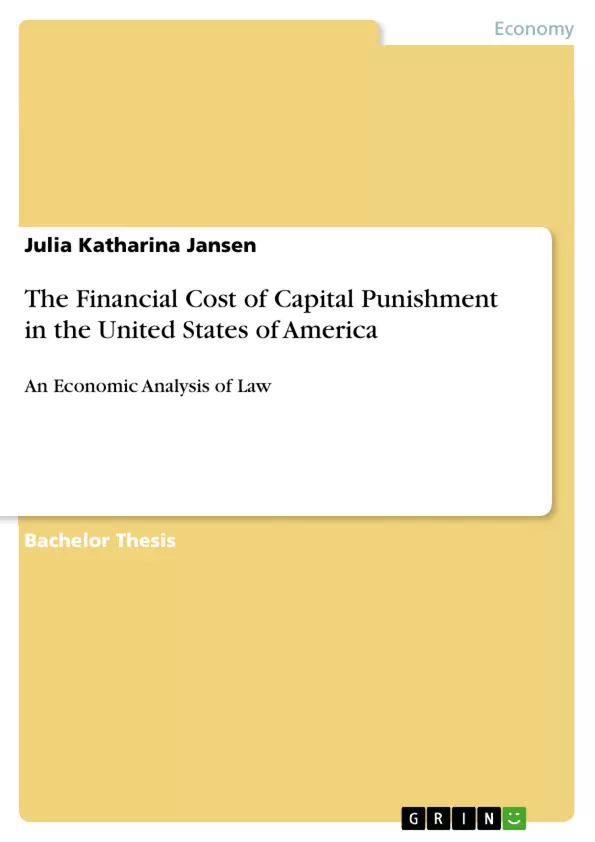Awareness surrounding the financial burden of capital punishment is increasing and slowly beginning to permeate the American Society. However, not enough light has been shed on the sources that are causing the financial devastation. The death-is-different legal doctrine in the United States grants procedural protection that is unique for capital litigation providing individual consideration for each case.
The paper investigates the price increase by capitally adjudicating a case compared to a non-capital litigation. Looking at the economic side of the impact of legal statutes should contribute to the discussion about choosing alternative punishments, such as life incarceration without the possibility of parole, and the systems' improvement prospects or the lack thereof. In the aftermath of a severe economic crisis and with ongoing financial solvency crises of interdependent nations, cost cutting considerations become all the more essential. Further, it is “Time to consider whether maintaining the costly death penalty system is being smart on crime” by briefly looking into where the money could be invested instead in order to achieve an equivalent effect.
In short, the paper aims at ascertaining the financial cost of capital punishment and how the discoveries can impact jurisprudence. The central questions are the following. How to approach the financial cost of death penalty? What are the cost drivers of the system? Are there calculable benefits? How did and can economic arguments influence the legitimacy of capital punishment?
The paper is structured as follows. The introduction is designed to lay out the framework of the United States capital punishment system. The main part provides an overview of the developments in approaching the cost of state-sanctioned killing, then explores the key cost drivers and finally takes the reader through the difficulty of quantifying benefits. The main part concludes with a section offering a deduction of how economic reasoning may impact jurisprudence. At last, the conclusion presents final remarks.
Inhaltsverzeichnis (Table of Contents)
- 1. INTRODUCTION OR "DEATH IS DIFFERENT"
- 1.1. DEFINITION OF SCOPE AND KEY WORDS
- 1.2. PUTTING DEATH PENALTY INTO PERSPECTIVE
- 1.3. ARGUMENTS POLARIZING THE DEATH PENALTY DEBATE
- 1.4. QUESTIONING THE CONSTITUTIONALITY OF DEATH PENALTY
- 1.5. ECONOMIC CRISIS AND THE ANTAGONIZING EFFECT OF SAVINGS IN CAPITAL CASES
- 2. CRITICAL ANALYSIS OF THE COST OF CAPITAL PUNISHMENT
- 2.1. THE EVOLUTION OF COST STUDIES
- 2.1.1. EARLY BEWILDERMENT PERIOD FOLLOWED BY THE LUCUBRATION PERIOD
- 2.1.2. THE POLITICAL PROPAGATION PERIOD AND THE UNFLINCHING PUBLIC
- 2.1.3. THE UNSUCCESSFUL WAKE-UP CALLS FOR A FINANCIALLY BURDENED NATION
- 2.2. REVEALING WHAT MAKES CAPITAL CASES MORE EXPENSIVE BY SCRUTINIZING SELECTED COST TRAPS
- 2.2.1. TRIAL ASSOCIATED COST AND THE LOOPHOLE OF PLEA BARGAINING
- 2.2.2. EXCESSIVE REVIEW PROCESS AND THE COSTLY ABIDANCE ON DEATH ROW
- 2.2.3. THE BOTTLENECK OF INSUFFICIENT EXECUTIONS AND THE INCONVENIENCE CAUSED BY THE DRUG SUPPLY SHORTAGE
- 2.3. THE BENEFITS OF JUDICIAL KILLING AND OPPORTUNITY BENEFITS
- 2.3.1. ARE THE(RE) BENEFITS WORTH THE COST
- 2.3.2. OPPORTUNITY BENEFITS
- 2.4. HOW ECONOMIC ARGUMENTS CAN IMPACT JURISPRUDENCE
- 3. CONCLUSION OR DEATH MAKES NO DIFFERENCE
Zielsetzung und Themenschwerpunkte (Objectives and Key Themes)
This research paper examines the economic cost of capital punishment in the United States of America. It explores the evolving debate surrounding the death penalty, focusing on cost-benefit analyses and the constitutional arguments surrounding its implementation. Key themes explored in this work include:- The escalating costs associated with capital punishment compared to life sentences.
- The influence of economic arguments on legal proceedings and policy debates surrounding the death penalty.
- The ethical and legal implications of the death penalty in the context of economic considerations.
- The role of public opinion and political pressure in shaping the application of capital punishment.
- The challenges and controversies surrounding the execution process and its impact on the criminal justice system.
Zusammenfassung der Kapitel (Chapter Summaries)
The first chapter introduces the concept of capital punishment and its place within the U.S. legal system. It defines key terms, discusses the arguments for and against the death penalty, and explores its constitutionality. The chapter also examines the impact of economic crises on the debate over the death penalty. Chapter two delves into a critical analysis of the costs associated with capital punishment. It explores the evolution of cost studies, revealing the complexities and variations in methodology. The chapter then examines specific cost traps associated with capital cases, such as trial costs, lengthy appeals processes, and the scarcity of execution drugs. It also investigates potential benefits of capital punishment and considers the concept of opportunity benefits, exploring alternative uses for the financial resources allocated to capital punishment.Schlüsselwörter (Keywords)
This work focuses on the economic analysis of capital punishment in the United States. Key terms and concepts include the costs of capital punishment, the debate surrounding the death penalty, cost-benefit analyses, constitutional arguments, legal proceedings, public opinion, political pressure, and the challenges of implementation.- Quote paper
- Julia Katharina Jansen (Author), 2011, The Financial Cost of Capital Punishment in the United States of America, Munich, GRIN Verlag, https://www.grin.com/document/187972



